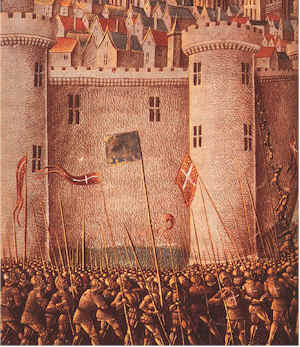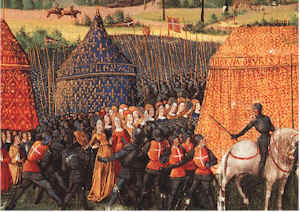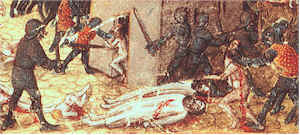|
|
|
|
The Crusaders
attack outlying forts
The opening moves in the crusader assault on Antioch opened with the capture of its port, St Symeon by a crusading fleet of around 30 boats. This fleet was probably crewed crewed by Englishmen who had fled England after the Norman conquest, and were now in the service of Alexius. The possession of the port, located about 12 km downstream from Antioch, was vital for the crusader, since it gave them access to supplies shipped across from Cyprus. The land attack began some time later with the capture of the Iron Bridge, a fortified crossing of the Orontes River. This bridge provided a vital link to the neighbouring Islamic states, and was to play host to a series of battles. After a fierce battle, the defenders fled, leaving the crusaders in control of the Orontes valley. |
|
|
The defenders prepare
Yaghi Siyan had a force of around 4,000, adequate for the task of defence, but no more. His only hope was to hold the crusaders off for long enough for help to arrive. Most of the people of Antioch were Christians, and Yaghi Siyan was worried that they might rise against him. He banished all the Christian men from the city - keeping their wives and children as hostages. The Crusaders arrive The crusaders arrived at Antioch itself on around October 21, 1097. Tatikios, the Byzantine representative, urged the Crusade leaders to mount a distant siege, sit out the winter in safety and resume the campaign in the Spring. Raymond urged a close siege which would prevent the army being dispersed, and it was his counsel that prevailed. |
|
| Even so,
large elements of the army were dispersed to guard the outlying areas.
Robert of Normandy, for example, left for Laodicea, another port which had
earlier been captured by the English fleet. From here he organised the
transport of food and other supplies from Cyprus. Other contingents of the
crusader army went to St Symeon and to outlying fortresses in Armenia.
The siege begins Antioch was too large for even the Crusader army to completely surround, or even to contemplate storming. They settled down to besiege the city, sealing off the gates one by one. Bohemond placed his army outside the St Paul Gate, with the northern French, commanded by Robert of Normandy, Robert of Flanders, Stephen of Blois and Hugh of Vermandois, on his right. To the right of them, outside the Dog Gate, stood the southern French, under the command of Raymond of Toulouse and Adhémar of Le Puy. Godfrey's forces took up the dangerous position outside the Gate of the Duke, sandwiched between the wall and the Orontes. Tatikios positioned the Byzantine forces somewhat back from the walls and behind the front line, defending the besiegers from attacks down the Orontes valley. The Bridge Gate, protected by the Orontes, was left without a blockading force. This gate controlled the road to the port of St Symeon, and the struggle to control the area in front of it was to form a crucial part of the siege. |
|
| Although at first the crusaders had a plentiful supply of food from the areas around Antioch, the size of their army meant that they soon ran out. The garrison did all they could to exacerbate this with frequent sallies from the Bridge Gate, cutting of the crusaders supplies from St Symeon and Laodicea. A Turkish-held fort, Harem, which lay some miles to the East of Antioch, also mounted repeated skirmish attacks. |
The plight of the
crusaders at Antioch When, Yaghi Siyan, the Emir of Antioch (that is, prince and lord) saw how heavily he was besieged by us, he sent his son, Shams ad-Daula by name, to ask for the help of Prince Ridwan of Aleppo and Prince Duqaq of Damascus. As a result, twelve thousand picked Turkish soldiers came immediately to aid Antioch. Being totally ignorant of this, we had sent many of our knights to nearby cities and fortified towns. Letter from Stephen of Blois to his wife, Adele. |
| These were
attacks were so troublesome that the crusaders built a fort, which they
named Malregard, on a hill to the east of Bohemond's camp to protect this
flank of the army. To held defend the road to St Symeon from raids launched
through the Bridge Gate, Godfrey's forces built a bridge, the Bridge of
Boats, across the Orontes to their rear. This allowed them to cross the
river to meet attacks which had crossed via the Bridge Gate. Tancred,
meanwhile, was given a fee of 40 silver marks per month to take his small
troop to watch the St Georges Gate on the south wall.
The crusaders send out foragers In mid-December, as the surrounding area became stripped of food, and the situation of the besiegers became more desperate, the army council made a decision to launch a major foraging expedition. This large force, commanded by Bohemond and Robert of Flanders, travelled up the Orontes Valley as it curved round to the south. |
|
| As luck would have it, they happened upon a relief army under the command of Duqaq. Duqaq had left Damascus earlier that month accompanied by his atabeg, Tughtigin, and Janah-ad-Dauluh of Homs. Both sides were taken by surprise and, although the crusaders were driven from the field, they inflicted enough damage on the Duqaq's forces to convince him to return to Damascus. The crusaders returned to Antioch empty handed. |
The plight of the
crusaders at Antioch We were thus left in the direst need, for the Turks were harrying us on every side, so that none of our men dared to go outside the encampment. The Turks were menacing us on the one hand, and hunger tormented us on the other, and there was no-one to help us or bring us aid. The rank and file, with those who were very poor, fled to Cyprus or Rum or into the mountains. We dared not go down to the sea for fear of those brutes of Turks, and there was no road open to us anywhere. The anonymous author of The Deeds of the Franks. |
|
The crusaders
starve
The winter was a desperate time, and many of the Crusaders died from a combination of starvation and exposure. As morale dropped, people began deserting - most notably William the Carpenter (the Lord of Melun) and Peter the Hermit. Both these men were later rounded up by Tancred and brought back to the camp. |
|
| By January, the Provençal knights had lost so many horses that they began refusing to escort the foraging parties. In response, the leaders tried several measures to lift spirits. Compensation was offered to knights who lost their horses in battle. There were religious events and, in February, Adhémar called for the expulsion of the women from the army camp. Tatikios, whose position among the western crusaders had become increasingly untenable, left the siege to return to Byzantine-controlled territory. |
|
|
Ridwan of
Aleppo attempts to lift the siege
It was around this time that a second relief force, under the command of Ridwan of Aleppo, approached Antioch. The crusaders had few mounted knights left to meet this new threat, but those that they had, maybe only 700 in total, they amalgamated into a single force under the command of Bohemond. Under cover of darkness, this force slipped out and laid an ambush for the approaching army. Bohemond divided his army into six squadrons and hid them behind a low hill. As Ridwan's army approached, the first five squadrons charged down upon his vanguard. They panicked and fell back upon the main force as it tried to deploy. Ridwan managed to rally his troops but, just as it looked as though the crusaders would be overcome, Bohemond launched his reserve upon Ridwan's main army and put them to flight. Spring brings hope for the crusaders By the spring, supply routes had been improved. The Armenians had captured Harem, a large fort which had been a thorn in the crusader's side since the start of the siege. Because of this and other actions, there was now a steady flow of food from Edessa and from Cyprus along roads and through ports controlled by the crusaders. In March, another tower, Mahommeries, was constructed, this time by Raymond's forces, Mahommeries blocked the Bridge Gate, giving protection to supply columns travelling up from St Symeon and further tightening the noose around Antioch. Bohemond makes a deal |
|
| Meanwhile, it was Bohemond who held the key to the cities demise. He had been in secret negotiations with a man called Firuz, who commanded one of the towers on the south-eastern part of the wall. Firuz was an Armenian, recently converted to Islam but sympathetic to the Christians. He would let the crusaders into his tower. Bohemond wanted to strike a deal with the other crusade leaders. He would engineer the capture of the city, but his price was that Antioch would be given to him. |
Antioch betrayed Yaghi Siyan, emir of Antioch, displayed unprecedented bravery, presence of mind, wisdom and activity; consequently most of the Franks died there. Yaghi Siyan did not fail to provide for the needs of the families of the Christian men whom he had forced to leave the town, and he prevented those - who otherwise would have been tempted - from doing them wrong. Finally, despite these precautions, the Franks came to an agreement with the commander of one of Antioch's towers, a breastplate-maker called Firuz: they promised him silver and considerable wealth if he would betray the city to them. Ibn al-athir, The Sum of World History. |
| The other
leaders demurred, some wanted the city to be split equitably, some felt that
they should honour their oaths to Alexius and give the city to the
Byzantines. None of them wanted to simply hand such a powerful prize over to
Bohemond.
Kerbogha approaches In the end, it was the approach of a third relief army that forced them into a decision. The relief army, commanded by Kerbogha, the Turkish ruler of Mosul, was far more powerful than any they had had to face before. As well as his own troops, he had gathered allies from all around, including Arlan-Tasch of Sinjar, Qaradja of Harran, Balduk of Samosata, Janah-ad-Dauluh of Homs, and the still-powerful army of Duqaq. The news of his approach terrified the crusaders, and many deserted. The most notable of these was Stephen of Blois, who had no confidence in Bohemond's furtive plans. He boarded a ship on 2 June 1098 and sailed off to warn Alexius, who was approaching with his own army, that all was lost. |
|
| The crusader leaders knew that would be massacred if they were in the open when Kerbogha arrived, so they quickly agreed to Bohemond's plan. That same evening, 2-3 June, the crusaders stormed into the city through Firuz's tower. In the darkness, thousands of the city's residents, Christian and Muslim, were slaughtered. |
|
| Yaghi Siyan fled, accompanied by thirty bodyguards, only to be later captured and killed by Armenian Christians. The victory celebrations were short lived. Kerbogha's army arrived the next day and now it was the crusaders turn to be besieged. |
Yaghi Siyan
escapes Yaghi Siyan woke up and asked what all the noise was. His men told him that the trumpet calls were coming from the citadel, which must therefore have been occupied by the enemy. Now, the noise was not coming from the citadel but from the tower; nevertheless, Yaghi Siyan was seized with fear and, giving orders for one of the town gates to be opened, he fled, accompanied only by thirty attendants. Ibn al-athir, The Sum of World History. |




